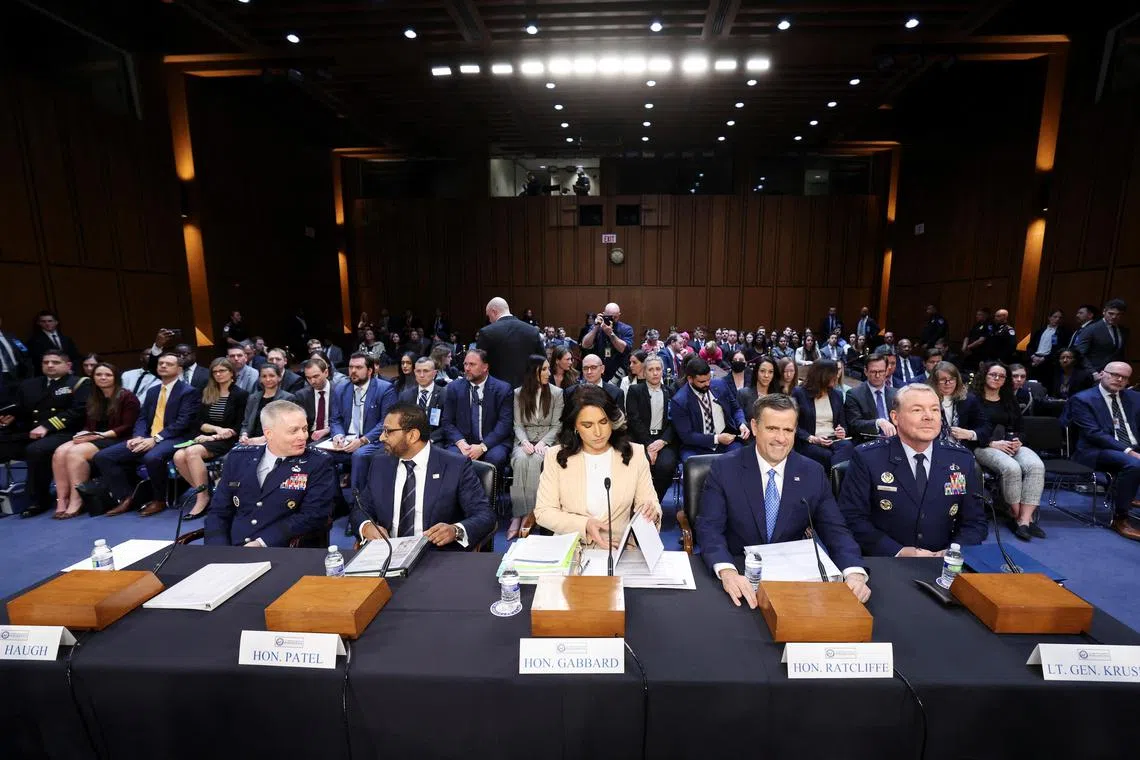China poses top military, cyber threat to US, intel chiefs say
Sign up now: Get ST's newsletters delivered to your inbox

(From left) US National Security Agency director Timothy Haugh, Federal Bureau of Investigation director Kash Patel, director of national intelligence Tulsi Gabbard, Central Intelligence Agency director John Ratcliffe and Defence Intelligence Agency director Jeffrey Kruse testifying on March 25.
PHOTO: REUTERS
Follow topic:
WASHINGTON – China remains the United States’ top military and cyber threat, according to a report by US intelligence agencies published on March 25 that said Beijing was making “steady but uneven” progress on capabilities it could use to capture Taiwan.
China has the ability to hit the US with conventional weapons, compromise US infrastructure through cyber attacks and target its assets in space, and is seeking to displace the US as the top artificial intelligence (AI) power by 2030, the annual threat assessment by the intelligence community said.
Russia, along with Iran, North Korea and China, seeks to challenge the US through deliberate campaigns to gain an advantage, with Moscow’s war in Ukraine having afforded it a “wealth of lessons regarding combat against Western weapons and intelligence in a large-scale war”, the report said.
Released ahead of testimony before the Senate Intelligence Committee by President Donald Trump’s intelligence chiefs, the report said China’s People’s Liberation Army (PLA) most likely planned to use large language models to create fake news, imitate personae and enable attack networks.
“China’s military is fielding advanced capabilities, including hypersonic weapons, stealth aircraft, advanced submarines, stronger space and cyber-warfare assets and a larger arsenal of nuclear weapons,” director of national intelligence Tulsi Gabbard told the committee, labelling Beijing as Washington’s “most capable strategic competitor”.
“China almost certainly has a multifaceted, national-level strategy designed to displace the United States as the world’s most influential AI power by 2030,” the report said.
Central Intelligence Agency director John Ratcliffe told the committee that China had made only “intermittent” efforts to curtail the flow of precursor chemicals fuelling the US fentanyl crisis
Mr Trump has increased tariffs on all Chinese imports
“There is nothing to prevent China... from cracking down on fentanyl precursors,” Mr Ratcliffe said.
The Chinese Foreign Ministry said it “advised the US not to use its own hegemonic logic to mirror China, and not to use outdated Cold War thinking to view China-US relations”, when asked about the report on March 26.
The ministry urged Washington to stop “condoning and supporting Taiwan independence separatist activities”, ministry spokesman Guo Jiakun said.
The spokesman for China’s embassy in Washington, Mr Liu Pengyu, said the US has long “hyped up” the China threat as an excuse to maintain US military hegemony.
“China is determined to be a force for peace, stability and progress in the world, and also determined to defend our national sovereignty, security and territorial integrity,” Mr Liu said, adding that “fentanyl abuse is a problem that the United States itself must confront and resolve”.
The committee hearing was overshadowed by Democratic senators grilling Mr Ratcliffe and Ms Gabbard over revelations that they and other top Trump officials discussed highly sensitive military plans in a Signal messaging app group
Numerous Republican senators focused their questioning on undocumented immigrants in the US. The intelligence report said large-scale illegal immigration had strained US infrastructure and “enabled known or suspected terrorists to cross into the United States”.
While Iran continued to improve its domestically produced missile and unmanned aerial vehicle systems and arm a consortium of “like-minded terrorist and militant actors”, they said, the US continues to assess that Tehran “is not building a nuclear weapon”.
US concerns about China dominated about a third of the 33-page report, which said Beijing was set to increase military and economic coercion towards Taiwan, the democratically governed island China claims as its territory.
“The PLA probably is making steady but uneven progress on capabilities it would use in an attempt to seize Taiwan and deter – and if necessary, defeat – US military intervention,” it said.
The intelligence agencies said China’s long-term goal was to expand access to Greenland’s natural resources and use it as a “key strategic foothold” in the Arctic.
US Vice-President J.D. Vance said he would visit Greenland this week while accompanying a high-profile US delegation. Mr Trump has angered Nato ally Denmark and Greenland with renewed calls for the US to take over the semi-autonomous Danish territory, calling the proposal a US national security imperative.
Still, the report said, China faces “daunting” domestic challenges, including corruption, demographic imbalances, and fiscal and economic headwinds that could impair the ruling Communist Party’s legitimacy at home.
China’s economic growth probably will continue to slow because of low consumer and investor confidence, and Chinese officials appear to be bracing themselves for more economic friction with the US, the report said. REUTERS

